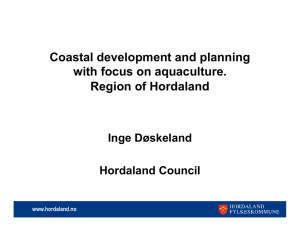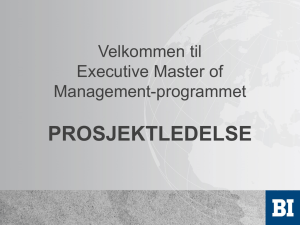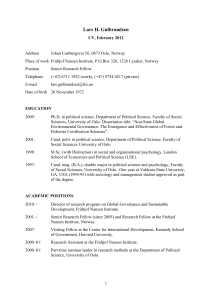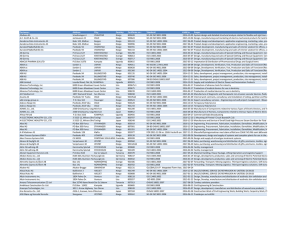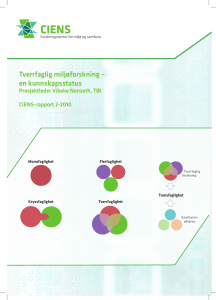Nye standarder
advertisement
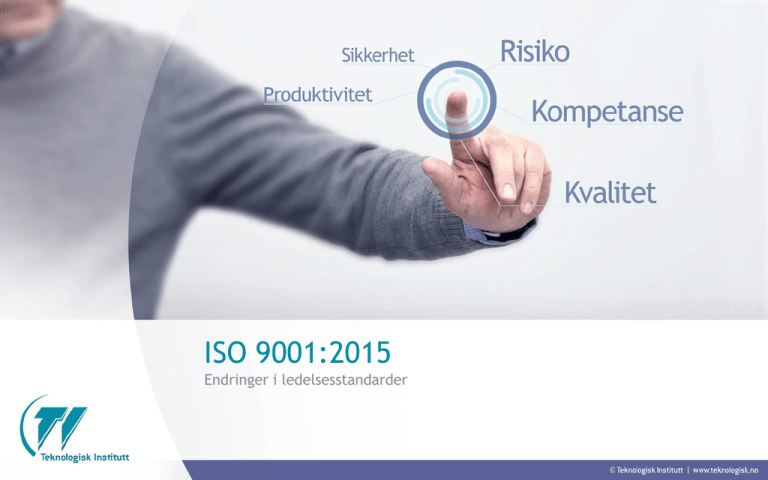
ISO 9001:2015 Endringer i ledelsesstandarder <<TEKNOLOGISK.NO>> 210 kollegaer Oslo (HK) Bergen / Ågotnes Stavanger Haugesund Trondheim Göteborg <<SERTIFISERING.NO>> VÅRE VERDIER HENSIKT MED STANDARD REVISJONER ISO standardene trenger å: – – – – – – – Opprettholde relevans Integrere med andre ledelsessystemer Gi en integrert tilnærming til organisatorisk ledelse Gi et konsistent grunnlag for de neste 10 årene. Reflektere de stadig mer komplekse miljøene en organisasjon opererer i Sikre at den nye standarden tar hensyn til alle behov til potensielle brukere Forsterke brukeres evne til å oppnå fornøyde kunder / interessenter NY STRUKTUR FOR LEDELSES STANDARDER (ANNEX SL, HIGH LEVEL STRUCTURE) Annex SL (normative) Proposals for management system standards Målet med dette dokumentet er å forbedre konsistensen og synkroniseringen av ISO ledelsesstandarder. – – – Enhetlig og bestemt struktur Identisk kjerne tekst og definisjoner av vanlige termer «Disiplin-spesifikke» krav for hver standard legges til HIGH LEVEL STRUKTURE (ANNEX SL) 4. Context of the organiszation 4.1 Understanding the organization and its context 5. Leadership 6. Planning 5.1 Leadership and commitment 6.1 Actions to address risks and opportunities 4.2 Understanding the needs and expecetations of interested parties 5.2 Policy 6.2 XXX objectives and planning to achieve them 4.3 Determining the scope of the XXX management system 5.3 Organizational roles, responsibilities and authorities 4.4 XXX management system 7. Support 8. Operation 9. Performance evaluation 10. Improvement 9.1 Monitoring, measurement, analysis and evaluation 10.1 Nonconformity and corrective action 7.2 Competence 9.2 Internal audit 10.2 Continual improvement 7.3 Awareness 9.3 Management review 7.1 Resources 7.4 Communication 7.5 Documented information 8.1 Operational planning and control NYE STANDARDER HAR IKKE EGET PUNKT FOR «FOREBYGGENDE TILTAK» En av de vesentlige hensiktene med et “styringssystem” er at det virker som verktøy for å forebygge. Kapittel 4. identifisere kontekst, interessenter og krav som kan påvirke måloppnåelsen Kapittel 6. kartlegging og identifikasjon av risikoer og muligheter som må adresseres. Kapittel 4 og 6 dekker forebyggende tiltak (grunnlaget for alle standarder er nå forebyggende) EKSEMPEL PÅ BRUK AV «ANNEX SL» Blå tekst er Strukturtekst som er lik for alle standarder Svart tekst er disiplinspesifikk (eksempelet er fra ISO 45001) 4. Context of the organiszation 4.1 Understanding the organization and its context 4.2 Understanding the needs and expecetations of interested parties 4.3 Determining the scope of the Quality management system 5. Leadership 5.1 Leadership and commitment • 5.1.2 Customer focus 5.2 Policy 5.3 Organizational roles, responsibilities and authorities 4.4 Quality management system and its processes 6. Planning 6.1 Actions to address risks and opportunities 7. Support 7.1 Resources 6.2 Quality objectives and planning to achieve them 7.2 Competence 6.3 Planning of changes 7.3 Awareness 7.4 Communication 7.5 Documented information 8. Operation 8.1 Operational planning and control 8.2 Determination of of requirements for products and services 8.3 Design and development of products and services 8.4 Control of externally provided products or services 8.5 Production and service provision 8.6 Release of products and services DIS ISO 9001:2015 8.7 Control of nonconforming process outputs, products, and services 9. Performance evaluation 10. Improvement 9.1 Monitoring, measurement, analysis and evaluation 10.1 Nonconformity and corrective action 9.2 Internal audit 10.2 Nonconformity and corrective actions 9.3 Management review 10.3 Continual improvement 9001 ENDRINGER Termen “dokumentert informasjon erstatter prosedyrer og registreringer. Ikke krav om kvalitetshandbok Økte krav til “ledelse” Ingen krav om ledelsens representant 9001 ENDRINGER .. Når planer for måloppnåelse etableres skal hvem, hva, hvor og når fastsettes. (6.2) Endringer skal planlegges (6.3) Tydelig referanse til kompetanseledelse. (7.1.6) Planlegging av operasjoner (realisering) skal adressere risikoer. (8.1) Forsterket fokus på prosessenes evne til å oppnå krav til varer, tjenester og kundetilfredshet. 9001 ENDRINGER … Kontroll med endringer (produkt og tjenester) (8.5.6) Sikre at overvåking og måling er implementert i henhold til kravene (9.1.1) Klare krav til analyse og evaluering (9.1.3) Tydeligere krav til at interne revisjoner skal ta hensyn til bla. kvalitetsmålene, aktuelle prosessers viktighet, kundeklager og endringer. (9.2) Ledelsens gjennomgåelse skal ta hensyn til organisasjonens strategiske retning. (9.3) 4. Context of the organiszation 5. Leadership 6. Planning 5.1 Leadership and commitment 6.1 Actions to address risks associated with treaths and opportunities 4.2 Understanding the needs and expecetations of interested parties 5.2 Policy 6.2 Environmental objectives and planning to achieve them 4.3 Determining the scope of the Environmental management system 5.3 Organizational roles, responsibilities and authorities 4.1 Understanding the organization and its context 4.4 Environmental management system 7. Support 9. Performance evaluation 10. Improvement 7.1 Resources 8.1 Operational planning and control 9.1 Monitoring, measurement, analysis and evaluation 10.1 Nonconformity and corrective action 7.2 Competence 8.2 Emergency preparedness and response 9.2 Internal audit 10.2 Continual improvement 7.3 Awareness 7.4 Communication 7.5 Documented information DIS ISO 14001:2015 8. Operation 9.3 Management review 14001 ENDRINGER Strategisk miljøledelse – – – Fokus på å forstå organisasjonens kontekst Interessenter Endringer Styring av miljørisiko (og muligheter) Økt fokus på ledelse og utøvelse av ledelse Fokus på å forbedre miljøprestasjonen (vs systemet) 14001 ENDRINGER .. Proaktiv miljøledelse (økt forventning til at miljøstyringen er proaktiv) Livssyklus tankegang (Relatert til produkter og tjenester) Kommunikasjonsstrategi (omfatter både intern og ekstern kommunikasjon) Tydeligere krav til etterlevelse av lov og forskriftskrav (og interessent) krav IMPLEMENTERINGS PLAN ISO 9001:2015 (DRAFT) Sept. 2015 • ISO 9001:2015 Publiseres Des. 2015 • Est. Første gjennomføring av sertifiseringer etter ISO 9001:2015 Mars 2017 ISO 14001:2015 forventes å følge tilsvarende plan, men forskjøvet noen måneder. ISO 45001:2016 (OHSAS) er ny som ISO standard og vil trolig ikke ha 3 års implementeringsplan. Det forventes allikevel at OHSAS 18001 standarden vil ha noe overlappende gyldighet med ISO 45001 • Alle nye sertifiseringer skal være etter 9001:2015 Sept. 2017 • Alle re-sertifiseringer etter 9001:2015 Sept. 2018 • ISO 9001:2008 trekkes tilbake PAUSE INTEGRERTE STYRINGSSYSTEMER JFR. REVIDERTE STANDARDER. Organisasjonens kontekst – – – – – – Hvem er vi ? ▪ Omfang ▪ Infrastruktur ▪ Ansatte, mm Hva gjør vi ? ▪ Prosesser / tjenester Hvem er interessenter ? ▪ Eiere (økonomi, strategiske ønsker mm) ▪ Kunder ▪ Ansatte ▪ Nærmiljø….. Hvilke krav stiller interessenter ? Hvilke lovkrav gjelder? HVA SKAL STYRES ?, I HVILKEN RETNING? RISIKO OG MULIGHETER En tenkt prosess består av å frakte møtedeltakere fra Flesland Flyplass til Hotell i nærområdet. Mål: Frakte alle deltakere enkelt, trygt, komfortabelt, til rett tid, til forutsigbare kostnader med fornøyde medarbeidere. RISIKO OG MULIGHETER En tenkt prosess består av å frakte møtedeltakere fra Flesland Flyplass til Quality Hotel. HSM: Trafikkulykker, Stress, - Usikkerheter? Miljø: Utslipp fra bil, brann, søl, - HMS risikoer? støy - Miljørisikoer? Kvalitet: Kunde kommer for sent, - Kvalitetsrisiko? komfort i bil, Betaling, Feil pris Ta 2 minutter og diskutere med sidemann hvilke usikkerheter man kan tenke seg her Enkelt, Rett tid, Komfortabelt, Trygt, Kost / pris, Medarb, DB MULIG TANKESETT? Hvilke krav gjelder? Risikoer og muligheter Bestilling § Bekrefte Planlegge, samsvar gjennomføre Er det usikkerheter Stress, rett tid,krav Hvordan kanmed dette og forebygge knyttet til komfort, utslipp påvirke kjøretiden? …. måloppnåelsen? Hente Kjøre Overvåkes endringer Fornøyde interessent er Levere og ta betalt § DEFINISJON AV RISIKO 3.09 risk effect of uncertainty on objectives – Note 1 to entry: An effect is a deviation from the expected — positive or negative. – Note 2 to entry: Uncertainty is the state, even partial, of deficiency of information related to, understanding or knowledge of, an event, its consequence, or likelihood. Note 3 to entry: Risk is often characterized by reference to potential events (ISO Guide 73, 3.5.1.3) and consequences (ISO Guide 73, 3.6.1.3), or a combination of these. Note 4 to entry: Risk is often expressed in terms of a combination of the consequences of an event (including changes in circumstances) and the associated likelihood (ISO Guide 73, 3.6.1.1) of occurrence. – – 6.2.1 INTEGRERT EMS / QMS 6.2.1 Environmental / Quality objectives The organization shall establish environmental / quality objectives at relevant functions and levels and processes: – – taking into account the organization’s significant environmental aspects and its compliance obligations; considering the risk associated with threats and opportunities. When developing these objectives, the organization shall consider its technological options and financial, operational and business requirements. BLÅ = Annex SL Grønn = EMS spesifikk Svart = QMS 6.2.1 .. The environmental objectives shall: – – – – – – a) be consistent with the environmental policy; b) be measurable (if practicable); c) be monitored; d) be communicated; e) be updated as appropriate. f) “be relevant to conformity of products and services and the enhancement of customer satisfaction”; The organization shall retain documented information on the environmental / Quality objectives. 4. Context of the organiszation 4.1 Understanding the organization and its context 4.2 Understanding the needs and expecetations of interested parties 4.3 Determining the scope of the Quality management system 5. Leadership 5.1 Leadership and commitment • 5.1.2 Customer focus 5.2 Policy 5.3 Organizational roles, responsibilities and authorities 6. Planning 6.1 Actions to address risks and opportunities 6.2 Quality objectives and planning to achieve them 6.3 Planning of changes 4.4 Quality management system and its processes 7. Support 7.1 Resources 7.2 Competence 7.3 Awareness 7.4 Communicatio n 7.5 Documented information 8. Operation 8.1 Operational planning and control 8.2 Determinatio n of of requirements for products and services 8.3 Design & development of products and services 9. Performance evaluation 9.1 Monitoring, measurement, analysis and evaluation 9.2 Internal audit 9.3 Management review 8.4 Control of externally provided products or services 8.5 Production and service provision 8.6 Release of products and services ISO 9001:2015 + ISO 14001:2015 8.7 Control of nonconforming process outputs, products, and services 8.2 Emergency preparedness and response 10. Improvement 10.1 Nonconformity and corrective action 10.2 Nonconformity and corrective actions 10.3 Continual improvement TAKK FOR OPPMERKSOMHETEN <<hsc@ti.no>> Kilder: DIS ISO 9001:2015 DIS ISO 14001:2015 www.iso.org <http://www.iso.org/iso/1n1000_iso_ 14001_revision_information_note_update_july2014.pdf> http://www.iso.org/iso/tc207sc1home <http://isotc.iso.org/livelink/livelink/open/tc176SC2public>
